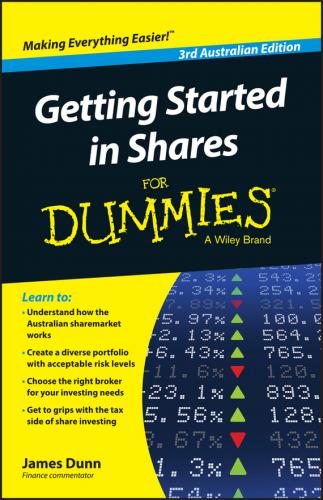Making the Most of Share Investing
Investing in shares offers five big pluses. The first two pluses that I discuss in this section are the most critically important. The other three pluses are bonuses, one literally so.
As a company’s revenue, profits and the value of its assets rise, so does the market price of its shares. Subjective factors, such as the market’s perception of the company’s prospects, also play a part in this process. After you’ve looked through this book, you’ll know how to put together a share portfolio that makes the most of this crucial ingredient – capital growth.
Recently another reason for owning shares – or more correctly, a bonus for shareholders – has emerged in the form of the discounts companies offer to shareholders on their goods and services. Many companies offer some form of discount, and the number of companies making these offers is growing. These businesses realise that any inducement they can give people to buy their shares makes good marketing sense. Shareholder perks range from holiday deals to wine, shopping and banking discounts. For example, gaming and wagering company Tabcorp offers shareholders free entry into certain horseracing meetings, plus accommodation and food and beverage discounts at the company’s hotels and casinos.
A major attraction of shares as an asset class is that they are extremely liquid, meaning that you can easily buy and sell them. The stock exchange’s trading system, ASX Trade, can match virtually any number of shares put on the market by a seller, with a buyer for that amount of shares. Some shares are less liquid than others; therefore, if you buy unpopular shares, they may be hard to sell.
A share portfolio is easily divisible. If you, the shareholder, need to raise money by selling some shares, you can sell any number to raise any amount. Divisibility is a major attraction of shares as compared to property. You can’t saw off your lounge room to sell it, but you can sell 500 Telstra shares with one phone call – or at the click of a mouse.
Guarding Against Risk
Share prices fluctuate continually and can move in a downward direction for extended periods of time. You can’t get a signed, sealed and delivered guarantee that a share’s price will rise at all after you buy it.
You can minimise but never avoid the risk that accompanies investing in shares. Share investment is riskier than alternative investments, but after you discover how to keep that risk under control, you can use this knowledge to build wealth for you and your family. I discuss the possible risks you can encounter and how to minimise their effects in Chapter 4.
Sharemarket slumps are an occupational hazard to investors, but the great global sharemarket slump of 2007–09 was a doozy. Very quickly it went from being a crash to a bear market, with the Australian stock market losing 52 per cent of its value – or $690 billion – between November 2007 and February 2009. The Australian market was not alone:
According to the World Federation of Exchanges, its 53 member markets lost US$34.4 trillion in value between November 2007 and February 2009; a fall of 54.5 per cent.
The bluest of blue chip Australian stocks were hammered in the GFC slump: Rio Tinto lost 80 per cent; BHP, 41 per cent; ANZ Bank fell 63 per cent; Commonwealth Bank slumped by 61 per cent; National Australia Bank lost 60 per cent and Westpac plunged 53 per cent. Wesfarmers lost 63 per cent, Telstra lost 40 per cent. The best-performing blue chip, Woolworths, managed to limit its loss to 30 per cent.
The slump had its roots in the early part of the 2000s, when the US economy struggled to deal with recession and the shock of the September 11 terrorist attacks. To stimulate the economy, the Federal Reserve Board cut US interest rates, all the way to a 46-year low of 1 per cent, in 2003.
The monetary treatment worked on the economy, but a side effect of the historically low rates was to kick off both a debt binge and the biggest housing boom in US history. Both individuals and companies simply took on far too much debt.
As people scrambled to get into the US housing market, banks and non-bank lenders adopted a market-share-at-all-costs attitude, with lending standards going out the window.
House prices were pushed higher as more people got home loans, making lenders even more eager to lend. Sub-prime lending (to borrowers with poor credit histories and limited capacity to service their loans) grew to account for 25 per cent of total US home loans. Many of these loans were packaged by investment banks into mortgage-backed securities and sold around the world. But when US house prices began to fall in 2006, the bubble burst.
Faced with falling house prices, sub-prime borrowers simply walked away from their loans, because many owed more than their houses were worth. Because the mortgages weren’t being paid, the cash flows on the mortgage-backed securities collapsed, which led to the prices of those securities plunging. No one wanted to buy them. Falling prices meant margin calls for many hedge funds and investment banks that held these securities: Suddenly unable to sell what had become illiquid assets, investors found they had to sell higher-quality, more liquid assets to raise money – thus spreading the contagion into other
